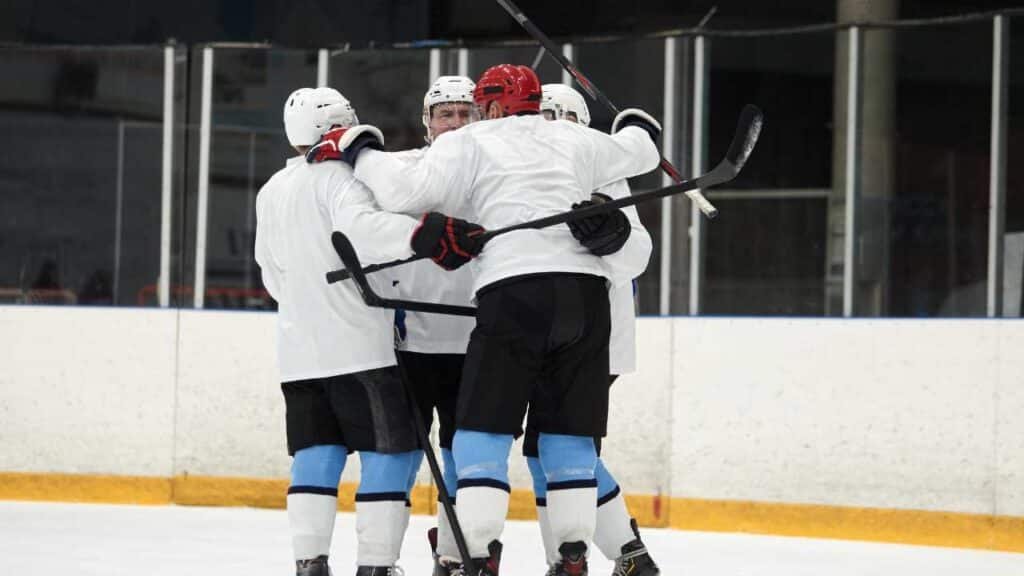Discover How Many Halves In Ice Hockey on our website . Learn about the game’s structure and rules in 140-160 characters.

If you’ve ever found yourself in a conversation about ice hockey, you might have been asked about halves, leaving you puzzled. Is there a second half, just like in many other popular sports? The answer might surprise you. But don’t worry; we’re here to unpack everything for you.
- Ice hockey is traditionally divided into three 20-minute periods, not halves.
- Games start with a face-off at the center circle and are resumed with a face-off after every goal or at the start of each new period.
- In between each period there are intermissions, providing players a break and also allowing time for resurfacing the ice.
In this article, we will clarify the basic structure of an ice hockey game, focusing on halves and periods. We’ll guide you through the flow of a game, making it even more enjoyable and understandable for you to share with others.
“Knowledge of a game’s ins and outs always enhances the overall experience of watching and enjoying it. We’re here to help you understand the structure of ice hockey.”
How Many Halves In Ice Hockey
When we delve into the exciting and adrenaline-fueled world of ice hockey, it’s essential to understand that, unlike sports such as basketball, soccer, or American football, ice hockey isn’t divided into halves. Instead, a standard regulation ice hockey game is comprised of three distinct 20-minute periods.
This might initially leave some sports enthusiasts scratching their heads. After all, a majority of sports commonly split their gameplay into two halves. However, in ice hockey, this unique three-period structure helps to maintain a rapid pace and tight gameplay experience that ice hockey fans have come to love. The clock ticks down in real-time during these periods, except for stoppages in play due to penalties, injuries, or timeouts.
Between each period, a 17-minute intermission takes place. These pauses allow athletes to rest, coaches to refine strategies, and Zambonis to smooth out the ice surface for optimal play conditions. The total duration of an ice hockey game, including these intermissions and potential stoppages, typically ranges from two to two-and-a-half hours.
A situation that might extend the length of an ice hockey game is the occasion of a tied score at the end of the third period. Should this occur, the game heads into overtime. Overtime rules can vary depending on the level of play and league regulations but often take the form of a sudden-death period where the first team to score wins the game.
So next time you’re watching an ice hockey match or debating sports trivia with friends, remember: there are no halves in ice hockey, but three intense periods of play that contribute to making up one electrifying game.
What is the structure of an ice hockey game?
Ice hockey games are broken down into distinct parts or sections, which aren’t, as you might expect, called ‘halves.’ An ice hockey game is actually made up of three periods, each 20 minutes long, not two halves, as in many other sports. After the first and second periods, there’s a 15-17 minute intermission during which the players take a breather, and the ice surface gets smoothed out by a Zamboni machine.
However, ice hockey games can extend beyond the standard three periods. If the teams are tied at the end of the third period, they go into sudden death overtime. Now, this is where it gets a little bit complicated, as overtime rules can vary depending on the level of play. In professional hockey leagues like the NHL (National Hockey League), during the regular season, teams will play a five-minute, three-on-three sudden-death overtime period. If the score remains tied after this overtime period, a shootout ensues. Meanwhile, in the playoffs, teams play full 20-minute sudden-death overtime periods until a winner is decided.
On the other hand, in college and high school hockey in the United States, overtime periods vary from a five-minute, four-on-four sudden death period up to a 20-minute, five-on-five sudden death period. Some games may end in a tie if no winner is decided after one overtime period. There are even instances where multiple 20-minute sudden-death overtime periods are played until a winner is finally decided. These variations in overtime rules can make ice hockey games incredibly suspenseful and unpredictable!
It should be noted that the duration of a hockey game is not solely determined by the length of the periods. Other factors, such as the time it takes play to resume after a stoppage, intermission length, and possible overtime, extend the size of the game further. Altogether, a regulation-time professional ice hockey game will typically last around 2.5 to 3 hours.
So, to circle back to the original question – “how many halves are in ice hockey?”- the answer is none. Instead, there are periods and, on occasion, an exciting, edge-of-your-seat overtime period that isn’t included in the original three-period structure!
How long is each period in ice hockey?
You might have heard about periods in Ice Hockey, but how long do they really run? The answer is relatively straightforward. An ice hockey game is divided into three periods, each lasting 20 minutes. That’s right, unlike soccer or basketball, which have two halves, ice hockey has three distinct periods.
These three periods embody the essence of ice hockey, providing plenty of time for scoring goals, strategic maneuvers, and unpredictable, edge-of-your-seat action. Ready for a bit of trivia? The division of the game into periods rather than halves originated in the early days of ice hockey when natural ice was used and the conditions could change drastically during the course of a match!
Remember, though, that we only discussed the ‘pure’ playing time. In reality, a hockey game lasts significantly longer than 60 minutes. Why? Because the clock in ice hockey, unlike many other sports, only runs when the puck is in play. This means that the clock stops for penalties, goals, timeouts, and any action where the puck exits the rink.
And let’s not forget the intermissions. Ice hockey also features two intermissions, each lasting 17 minutes, between the periods. These break times offer both the players and spectators a chance to rest and regroup ahead of the thrilling action that each new period promises. Combining all these components, a typical ice hockey game can run 2.5 to 3 hours in duration.
As an ice hockey enthusiast, having a thorough understanding of the game’s timeline ensures that you fully appreciate the pace, intensity, and unique dynamics of this exciting sport. And if you’re new to ice hockey, don’t fret; like any new language, you’ll start picking up the nuances and lingo in no time!
Overtime periods may be added if the game is tied after three periods. While many sports are neatly split into two halves, ice hockey takes a different approach. Instead of a seamless transition from one half to the next, you’ll find the game is broken down into three separate periods, each lasting 20 minutes in professional leagues.
Understanding this, you might ask, why three periods? The roots of this structure reach deep into the history of the sport when outdoor rinks were more prevalent. Two intermissions provided opportunities for the surface to be smoothed again with a Zamboni for optimum playing conditions. This convention has endured even in modern times with indoor ice arenas.
These periods are not just back-to-back playing time, though. Between each, there’s an intermission of about 15 to 17 minutes, depending on the league rules. This brief break gives players a chance to rest and strategize with their team, and it allows spectators to catch their breath after exciting plays.
In the event of a tie at the end of these three periods, an overtime period is commonly used to determine the winner. Its length and format vary depending on the specific league rules and whether it’s a regular-season or playoff game.
But remember, even with overtime, the concept of ‘halves’ doesn’t apply in ice hockey, as the fundamental structure relies on a tripartite or three-period system. By taking into account intermissions and possible overtime play, it’s easier to understand the dynamics of a typical ice hockey match and the endurance required from the players to reach the final whistle.
How does the structure of professional ice hockey differ from college ice hockey?
- Professional ice hockey players can exert as much as they want, given that they can be substituted at any point in the game, whereas, in college ice hockey, players are often limited by strict substitution rules and shorter benches.
- The National Hockey League (NHL), which hosts professional hockey games, consists of three 20-minute periods, with a 15-20 minute intermission after the first and second periods. Alternatively, college ice hockey often employs a similar structure modified for specific intercollegiate competitions.
- College hockey games hold more importance on each individual game due to the limited number of games in a season, as compared to professional hockey where players figure in numerous matches in a much longer league format. This difference could impact the intensity and strategy of the games.
- In the professional sphere, games tied at the end of regulation move into an overtime period and, if necessary, a shootout to determine a winner. In college hockey, tie games at the end of overtime result in a shared point by both teams, with no shootout.
- Professional ice hockey permits more physical contact than college hockey. Hits that might lead to penalties in the college game are often deemed acceptable in the pros.
ice hockey might, given its similar intensity and relentless pace to other games like basketball or soccer, expect the games to be divided into halves. Yet, this notion is a bit misdirected. The structure of an ice hockey match does not involve halves; instead, it’s divided into three periods.
Yes, you heard it right, three periods, not two halves. Each period lasts for 20 minutes, accompanied by intermissions between each one. These breaks aim to provide players with an essential rest time period, vital for refreshing and strategizing for the following period. Just imagine the level of endurance players need to display, competing with the same level of aggression and vigor for a span of 60 minutes!
While the concept of halves is commonly used in football, rugby, or basketball games, it holds no relevance in the ice rink. Many might wonder why there is a unique format for three periods. It’s a tradition that has been adhered to since the inception of the game. The rhythm and flow of the game the three-period structure enables are part of what makes ice hockey distinctly captivating.
Now, it’s worth noting that there are exceptions to this structure. In the event of a tie at the end of the third period in professional ice hockey, an overtime period is held, and if the game continues to be tied, a shootout can decide the winner. However, these situations are typically exceptions, not the rule of how ice hockey games are sectioned.
As we have seen, ice hockey stands apart from several other sports in terms of its match structure. The next time you’re watching a game or playing one, remember—there are no halves in ice hockey, only periods. It’s one of the many features of the sport that makes it thrilling and unique in character.
Question and Answer
Q: How many halves are there in an ice hockey game?
A: Unlike sports like football and basketball, which are divided into halves, ice hockey is typically divided into three periods, not halves. So, technically, there are no “halves” in an ice hockey game.
Q: How long is each period in an ice hockey game?
A: In professional ice hockey, including the National Hockey League (NHL), each period lasts for 20 minutes of actual playing time, whereas in most college-level games, the periods are slightly shorter, generally 15-20 minutes in length.
Q: How does the game structure of professional ice hockey differ from college ice hockey?
A: The most noticeable difference between professional and college ice hockey is the length of the periods, with professional ice hockey periods running longer. Also, in professional ice hockey, there are often more stringent rules regarding player conduct and penalties.
Q: Do the rules of overtime apply in ice hockey like they do in other professional games?
A: Yes, similar to other sports, ice hockey also has provisions for overtime to resolve a tie score at the end of regulation time. However, the rules and gameplay during overtime may vary depending on the league. For instance, the NHL institutes a sudden-death format where the first team to score in overtime wins the game.
Final Thought
Uncover How Many Halves In Ice Hockey on our website. From its fast-paced, strategical gameplay to its unique three-period structure, it decidedly deviates from the ‘half-time’ norm of many other popular sports. Understanding the structure of the game only enhances our appreciation for the skill and tenacity of its players.
Recognizing that sports like ice hockey don’t operate under the traditional ‘two halves’ layout can be initially confusing, but it opens up an intriguing new perspective on sports performance. More extended periods could mean endurance comes into play more than in sports that use smaller segments.
A fun reminder, though? Irrespective of whether it’s a two-half football game or a three-period ice hockey match, what truly counts is the thrill of the game, the showcase of talent, and the memorable moments that remain with us long after the final whistle. That’s the universal beauty of sports.
Whether you’re a seasoned ice hockey fan or a newcomer to the sport, understanding the basic structure of the game provides a better context for enjoying and appreciating the match. So next time you watch a game, remember – there’s more under the surface of that ice than you might think!




